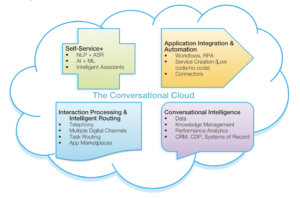 Spending on and deployment of the Conversational Cloud are growing rapidly. The underlying technologies are proving reliable and producing measurable improvements in both business results and customer experience. Here five factors that are shaping the market today and will have major impact for the next sixth months and beyond:
Spending on and deployment of the Conversational Cloud are growing rapidly. The underlying technologies are proving reliable and producing measurable improvements in both business results and customer experience. Here five factors that are shaping the market today and will have major impact for the next sixth months and beyond:
- “How do I [fill-in-the-blank]?” has replaced “What Is it?
For years discussions of “Conversational AI” routinely revolved around core definitions. With thousands of firms plowing ahead with plans to infuse customer care infrastructure with advanced analytics, natural language processing, machine learning and intelligent search, that issue is officially moot. Now enterprise decision makers focus on vendor selection and deployment strategies. They have done their homework and have business plans, productivity expectations and targets for both time-to-deploy and time-to-value. Solutions are no longer in a sandbox or “free demo”, they touch on systems and workflows that both employees and customers interact with in real-time. Success hinges on how well new, cloud based technologies connect to and interoperate with existing databases, systems and workflows. The hard work is just beginning. - Solutions Address Two Distinct Segments: “Novice” and “Experienced”
Experienced enterprises have one set of priorities, while new entrants tackle another. Novices often want the quickest path to a working “bot.” They adopt solutions that are “purpose built” to accomplish specific goals by automating specific, frequently invoked tasks. Over time, they compound complexity by launching separate bots for Mobile, Web and contact center instances. Experience transforms their key concerns from speed-to-deploy and speed-to-results into defining a way forward that brings multiple Bot projects under control, with a single source of truth and the ability to render accurate results from multiple sources across multiple channels. Their watchword is “orchestration” (and it’s not just “journey orchestration”). - “Business Continuity” Takes on New Meaning
The infusion of “Conversational AI” in cloud-based, premises-based and “hybrid” configurations has forever changed the definition of business continuity. Enterprise IT’s first foray into “the cloud” was driven by concern for business continuity. Fail-over to remote resources operated by 3rd party outsourcers (Now called BPOs) took place when there were seasonal spikes in traffic, power outages or other natural disasters. Today, departmental execs, as well as IT-specialists, can rely on reports that are generated by AI-infused resources to detect anomalies in calling patterns, agent performance and customer experience that signal a departure from business-as-usual and take pro-active measures to avert both minor and major disasters. - Impact is Enterprise-wide
The common theme established by the above predictions and put into practice during the ensuing 6 months is that investment in Conversational AI has enterprise-wide implications. Immediate and measurable results are garnered in contact centers; yet it is increasingly clear that executives in every department gain benefits from insights extracted from the “unstructured data” commonly known as conversations or chat transcripts. As advanced analytics and machine learning technologies are applied to the captured conversations, accuracy is improving, so is the ability to apply results to anomaly detection, which improves security and sentiment analysis, which fosters more empathetic interactions between and among employees and customers. - People, Not Technology, Are The Biggest Hurdles
Adoption and use of new technologies like Conversational AI are constrained by human factors. Agents are concerned about losing their jobs. Customers want to protect their privacy. Both expect new “AI-infused” ways of doing things to be an upgrade from the status quo ante. In both sets of cases, attention must shift to creating a better user experience by understanding individuals’ intents and delivering better-than-expected results.
Everything Involves a “Full Stack” Solutions
In very short order, every enterprise will be “experienced” with Conversational AI. They will know enough to realize that there are no “point solutions” or single purpose bots. All deployments call for a full stack solution spanning self-service, routing and employee or customer workflows, all informed by systems or record and transaction processing that may be decades of years old. In very short order, the fundamental question of “How do I make it happen?” will morph into “How do I leverage the benefits to my employees and entire customer base?”
Pragmatics are poised to prevail as bots or agent assistants seek to answer natural language input with responses from computing, data management and operations support systems that systems whose operating environments have not been updated for more than a decade. Expect venerable terms like “end-to-end service” and “full solution stack” to gain in importance as executives in key verticals like financial services, telecommunications, healthcare/insurance and government services make migration to the Conversational Cloud into an opportunity to bring antiquated computing, database management and communications platforms into the 21st Century.
Categories: Intelligent Assistants

 2025 Conversational AI Intelliview: Decision-Makers Guide to Self-Service & Enterprise Intelligent Assistants
2025 Conversational AI Intelliview: Decision-Makers Guide to Self-Service & Enterprise Intelligent Assistants  Talk to the Web: How NLWeb Opens Conversational Access to Site Content
Talk to the Web: How NLWeb Opens Conversational Access to Site Content  Battling ‘Botenfreude’: The Power of People and Policy
Battling ‘Botenfreude’: The Power of People and Policy  Voice AI Agents Redefine CX: Trends, ROI, and Strategies for 2025
Voice AI Agents Redefine CX: Trends, ROI, and Strategies for 2025